Eat Well, Spend Less: How to Store Pantry Food for Maximum Shelf Life
Back by popular demand, our series, Eat Well, Spend Less, will be returning once a month.
We all know the benefits of a well-stocked pantry. It’s essential for menu planning organization, helps maintain a healthy diet full of real foods, and saves you money by allowing you to stock up when food items are on sale.
But if food is not stored properly and is allowed to spoil, where is the value in buying in bulk? None whatsoever. That is why it is important to know how to store pantry food for maximum shelf life.
Waste in the average North American kitchen is at an all-time high. The numbers are shocking. Too much food is being thrown away. Is it coming from your kitchen? If so, you may be eating well, but you are certainly not spending less.
In the theme of our continuing Eat Well, Spend Less series, I thought we’d take a look at keeping all those groceries fresh and properly stored, and thus, keep more cash in our pockets.
Contamination = Cash Lost
Food spoilage occurs when:
- items are poor quality or damaged when purchased
- items are just plain old as the hills!
- items are stored incorrectly, allowing for damage to occur
What is damaging our food? Heat. Cold. Air. Light. Moisture. Smells. Critters. Any one of these factors can ruin our hard-earned food, and all can be prevented.
Ever since I witnessed my cat hunt down a mouse at 3 am, I’ve taken no chances with my pantry staples. Ingredients are rarely left in their initial packaging and great care is taken to store items properly. I’m not interested in losing a bag of organic steel-cut oats to ants or other foreign invaders!
How to Store Pantry Food for Maximum Shelf Life
Above is a snapshot of my pantry and the simple methods I use to combat food spoilage. As you can see, I don’t consider plastic bags or cardboard boxes effective for long term food storage. Dry ingredients need to live in a hard container like glass, hard plastic or metal and I use a combination of all three.
I’m a big fan of ‘containerization’, which is basically, Using Containers to Organize Your Kitchen Simply & Aesthetically, as I’ve already covered. Containers help organize because they group items and help combat the sprawl that tends to happen behind closed doors – and drawers.
Plus, by confining items to one place, they make clean-up less of a chore because that container can quickly be removed and washed under. They also combat many of those dangerous elements to our food such as moisture, air, and critters.
Here are a few of my favorites.
Glass Jars
Most of my dry pantry items are stored in glass jars. So are a lot of fridge and freezer items, for that matter. They are absolutely my storage container of choice and here’s why:
- They’re affordable.
- They’re reusable and recyclable.
- They display contents so I can find what I need in a glance.
- They are airtight.
- They have a rustic, country look to them that suits my kitchen.
Food I store in glass jars: grains, legumes, seeds, nuts, dried herbs, dried mushrooms, dried fruit, cereals, flour, pasta and more.
Tupperware
It’s hard to beat Tupperware when it comes to durable, airtight pantry storage. They are not as cheap as basic glass jars, but how many jars offer a lifetime guarantee?
I hosted two Tupperware parties several years ago, which more or less financed the Modular Mates I use. I love them for stuffing pretty much anything in, but mostly for those items that tend to get scattered over the pantry such as crackers, granola bars, dried fruit, and the like.
Large Tupperware containers allow me to maintain an orderly pantry so that any potential furry intruder will be bored – and hungry! The larger hard plastic containers help make cleaning much easier and keep the pantry sprawl to a minimum.
Food I store in Tupperware: flours, sugars, granola bars, chocolate, crackers, bread crumbs, ground nuts, and more.
Tins
Large or small, square or round: tins are ideal for containing small, easily scattered items like dried yeast packages or tea bags. Tins also provide a dry, dark, and airtight space, and one that I like to store some of my Asian ingredients in for maximum shelf life.
The drawback to tins is that you can’t see what is inside, and items can go unnoticed for some time if you’re not careful.
Foods I store in tins: Coffee, dried chilies & spices, seaweed, rice noodles, rice papers, tea, yeast, gelatin, and more.
Pantry Items to Store in the Freezer
Many foods should be kept in the freezer to extend storage life, especially during the humid months.
- Flours
- Nuts
- Spices – especially ground spices
- some grains such as wheat germ and flax
- Seeds – sunflower, sesame, etc
Ground spices retain their condition and quality best when stored in an airtight container in the freezer. Similarly, nuts and flours stay fresher for longer when kept cold. I store these items in glass jars in my chest freezer.
Final Thought: Food for Others
When so many exist daily with so little, we’re fortunate to have a stocked pantry. Hunger Awareness Week starts May 31, 2011 here in Canada, when food banks across the country will mark the day to raise awareness of the solvable issue of hunger in Canada. Find out how you can make a change and make a difference for Canadians in need.
In the US? One in six Americans are fighting hunger. Head to Feeding America to find a food bank in your area and plan to make a donation the next time you stock up on groceries.
Is there anything wasting away in your pantry right now?

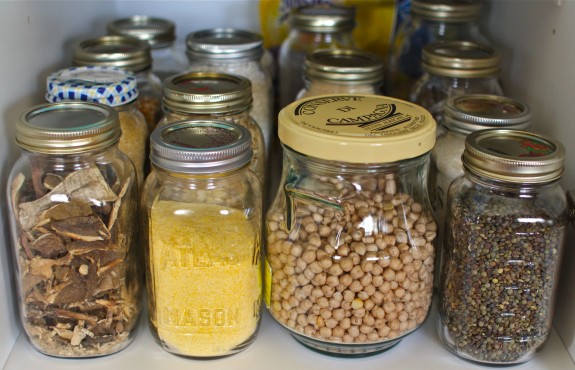

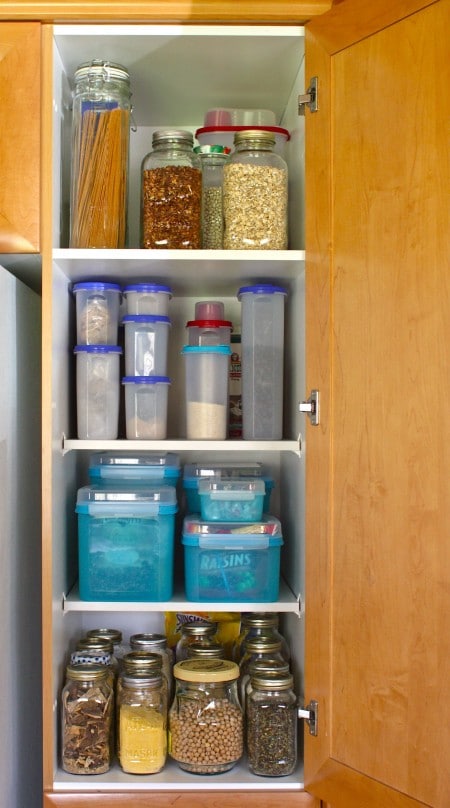
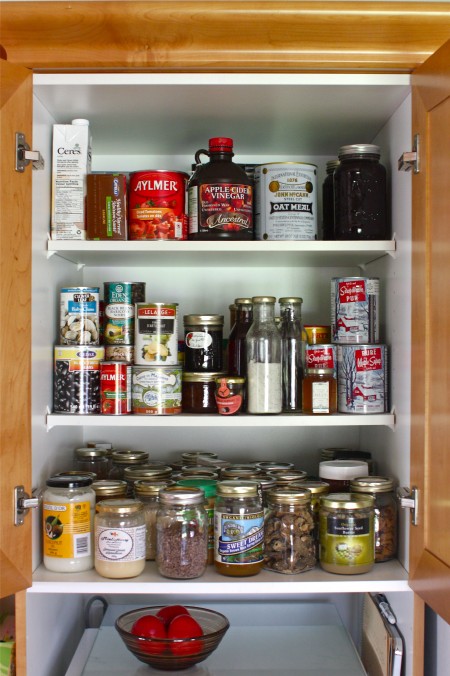

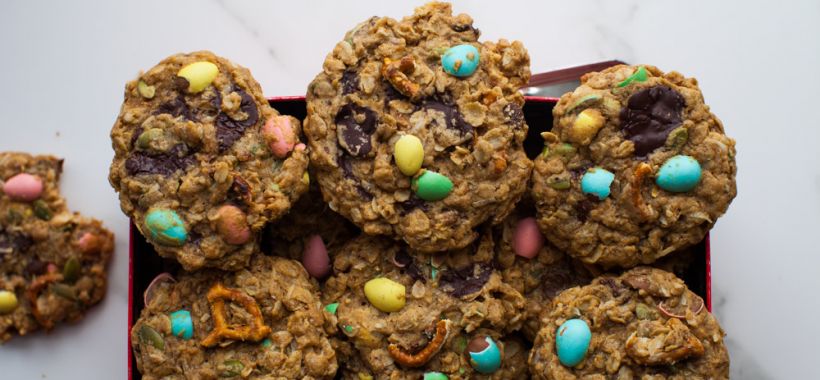
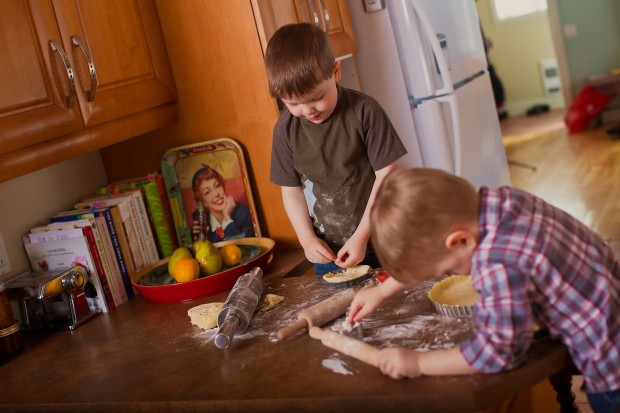
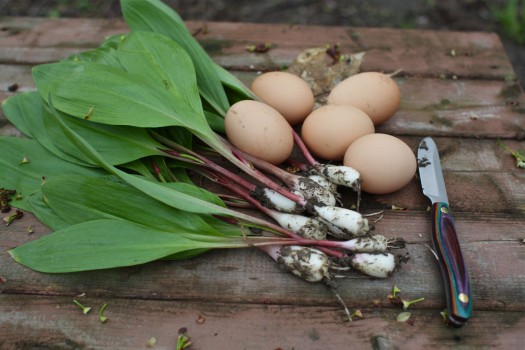
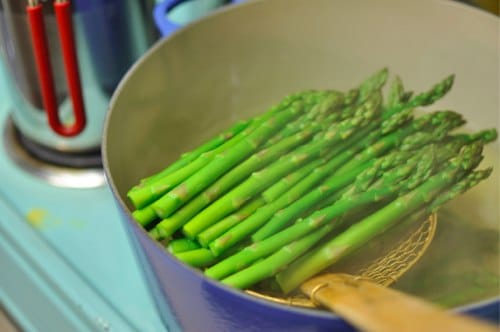
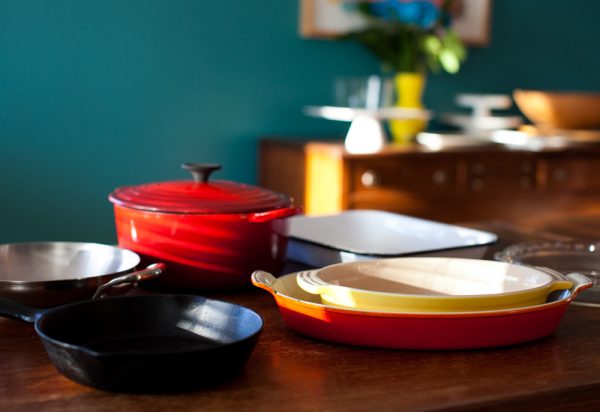
OMG you have the most organized cabinets I have ever seen! You make some very valid points about furry invaders…I think i’m going to make some print screens and start organizing my kitchen
Thank you for sharing how you store your pantry ingredients. I really enjoyed it. I love to store things in jars and containers, but I do not use them for everything. You might have convinced me to try it for more items like granola bars, crackers, and other snacks because I love how organized your pantry and cupboards look.
good to know all of this information!
now, excuse me, i’m going to buy some glass jars….
Don’t go buy glass jars… Just collect them as you empty out products that come in glass jars already – jam, pasta sauce, pickles, etc… No money spent, no glass heading to the landfill.
Or scope out a few garage sales this spring. There’s a long weekend coming up – it’s usually popular for garage sales.
Also, ask friends/family members if they have any jars you can put to use.
i didn’t think about that. good idea! thanks!
Very few things I buy in glass jars come in BIG glass jars besides pickles–I’m saving what I can but in the meantime, Walmart sells some nice gallon size glass jars, I bought a half dozen for the kids snacks and lined them up on the counter. (I’ve heard Ace sells half gallon canning jars but haven’t checked) It sure speeds up lunch packing to have everything lined up in jars like that and it’s cut WAY down on the number of times the kids bang the pantry door open and closed in a day looking for a snack.
You’ve inspired me to put my nuts in glass jar, they’ve been shoved in the back of the fridge in their sad little paper-clipped packaging. Off to shop my recycling bin! 🙂
I asked for jars and before I knew it I had bags of them being dropped off! I do not use canned pasta sauce or any items that come in jars really so all I did was ask my friends! It is a great idea and very green! I just don’t like pickle jars because I can never get the pickle smell out!
Hi, Heather!
Use baking soda and water to get rid of smelly jars! Fill the jar with water, stir in a couple of teaspoons of baking soda/soda bicarbonate, let it sit over night before you wash the jar.
great post! Now I know how I want to pantry to look! 🙂
What a great guide for being well organized in the kitchen! Thanks.
Thanks for the containerization link! I hadn’t discovered simple bites when that was first posted, but I needed to read those tips!
I see I’ve been missing the obvious–I store art supplies in old glass jars (and love the rustic look, like you said) but it never occurred to me to dump my legumes, nuts, oats etc in those as well. I vastly prefer glass to plastic, but have been using plastic for all those things.
Thanks for this. I have been looking for a better way to store things in my pantry. I’m changing over to using more dry beans instead of canned and was trying to figure out how to keep everything organized and contained and definitely away from critters. I do not want that! This post has been very helpful.
Great tips. Great looking pantry. Great that you have a cat…just in case 🙂
Please come fix my pantry, it’s ubber scary 🙂 Great tips by the way, now I just need to get busy.
I’m seriously impressed, Aimee. Your pantry is so organized! I love it.
We use a lot of glass jars in our pantry for dried fruit, flours, rice, nuts, and spices too. I love that they keep them safe and dry, and look so pretty. My pantry isn’t as organized as yours so I’m inspired to do a spring re-org soon! Thanks
Awesome, Gina! Of course, it isn’t always this nice, but all the containers do help the sprawl.
“containerization” – I like that 🙂
Thanks for letting us peek in your pantry, Aimee. I’m so glad that Eat Well, Spend Less is going to be a regular monthly feature. I learn so much and feel like my budget is benefiting, too.
Can you swing down to the US and do this to my cupbards??? Great tips girl!
Are you making cake? Then YES!
I keep my flours in my fridge. Should I move them to the freezer?
I love the look of your pantry. I need to get some mason jars, stat!
The fridge is definitely fine as long as you have space (I have more room in my deep freeze) and you are using the flour up within a few months.
Since I have a very small pantry space, I’m usually pretty good about using everything in my pantry…. except half a bag of dried split peas that I have no desire to use or recipe to use them for. They’ve been in there way too long, and I might decide to dig up a recipe for them before it gets too warm.
You are so organized! I never ever thought to use glass jars in my pantry, but that is brilliant!
I already a pantry disaster this spring. Ants! Lots of ants. The first time in three years. I hate ants!
I agree with the other commenter that it’s good to make sure you rotate your supply & buy things you normally eat, otherwise you could end up having to eat lots of things you don’t like before it goes out of date- ick! : )
You should see my collection of glass jars, none of which I bought. I just keep recycling anything I buy that comes in a good glass jar and re-purpose it for everything, even storing leftovers in the fridge.
Love the organization! Thanks for the tips.
I’ve been reading a lot about BPA in hard plastic. Does Tupperwear have BPA free containers?
I just bought a large bag of sunflower seeds (for homemade granola) last week and stuck it in the pantry. Off to put it in the freezer now! (My spices, too?! Good to know!)
I love your pictures! I stumbled onto your blog this morning and I already subscribed. I have most of my pantry in glass or plastic as well. I really like the convenience of it all. Plus, it looks so much prettier!
I have modular mates that I have been using since 1984. I absolutely love them. I never thought of using canning jars. I have far more of them than I need, as I inherited many from my grandmother. I’ll have to take a look at going through my pantry.
One thing I do, in compliment to the above, is to cut off the instructions of the package I bought my legumes, grains, etc. in and either tape or just stick it inside the glass container storage. Too many times I transfered something from its original package into a storage jar and then for got the water ratio or cooking time suggested!
Your pantry is much prettier than mine but here is what I do:
http://wholesavings.wordpress.com/2011/03/22/storing-bulk-purchases/
LOVE storing dry ingredients in ball jars! Glad to see you spreading the best storage tip ever! I’d also add – those OXO pop containters are overpriced. I bought a bunch for baking ingredients and while they’re OK, I just don’t think they’re worth it. Maybe the big ones for flour and sugar and stuff, but not for everything! Ball jars are much cheaper and much more attractive! 🙂
Great article and advise. I have never seen a pantry look so good! Your skills are wonderful!
Two questions – where did you get your tall jar for the spaghetti, and how do you label your jars? I want MY pantry to be beautiful, too! 😀
I love the level of organization shown here! This is going to be by summer project! Great tips, Aimee.
What a fantastic post… I have small bags (half used) stuffed in zip top bags of beans, legumes, and pasta… I almost always end up buying more not realizing there’s so much already in the cabinet. This would totally stop the extra spending (and wasting!) I believe I have some jars in the basement! I also love the idea of saving jars as you use them… I’ve been doing that for storing leftovers in the fridge, but hadn’t thought of it in this way. Thanks!
I am all about the jars! I got lucky and inherited about 200 from my hubby’s grandma…. i store everything in them! i love your organizing!
Your pantry is beautiful! I use the Jars For all my grains, too. But i somehow still end up with pantry moths. So I stopped buying more than I can use in a month. Id love to purchase in bulk, but I’m afraid those bugs will get to my grains and legumes and ruin my purchase. Any tips for keeping the worms and moths out?
Try taping a bay leaf on the bottom of each of the shelves in your pantry. I’ve never tried this, but have kept it in my mind to try if I seem to need something else.
Hi – just thought I would tell you I put bay leaves in all my dry goods (oats, rice, flour, beans, etc). I’ve been doing this for 30+ years with no bugs. I buy in bulk and store everything in glass jars or big plastic buckets. Hope this helps.
your organized pictures inspired me to finally move some of my bulk in bags to the glass jars i had waiting and also process my azure order i picked up and make my pantry look better.
Love your blog. This article is so helpful on so many levels. Thank you for clarifying each of the types of foods for each type of storage use. So helpful.
An easier way to not loose track of whats in your tins is painting them with chalkboard paint and writing on the front. Not only does it help identify the containment’s but also gives a streamlined black look for a prettier cabinet. 🙂
Great idea! I never even thought to use my Mason Jars as a way to store my food. Thanks for the tips
I have done the container organization method with my fridge, and it rocks. All ingredients for a specific meal are together in a container – and the container is labeled with the day of the week I’m making the meal on. It rocks.
There are so many things…. it’s hard to store them… Nice ideas….i like your post… thanks for sharing… 🙂
for any canning jars, do you glue the lid onto the ring at all? i imaging it being a pain to have to unscrew the ring and then take the lid off.
i’m wondering if i could use hot glue to glue the lid onto the ring and that still be okay with the food being stored in it
I so want to live in your kitchen!
I am curious…where did u get those awesome BLUE tupperware?? I LOVE them cuz they are HUGE
thanks
Felicia Nguyen
[email protected]
Love your pantry! I always am looking for glass containers for storage. One day all my pantry items will be in glass- yours looks fantastic!
hi my wife has just cleaned our ceramic storage jars in the dishwasher. however any food, coffee sugar etc we put back in them soaks up moisture. we have tried drying the jars for days on radiators,put them in the microwave, and dryed them with paper towels to no avail. Can you suggest anything, kind regards David M Pearce
I just wanted to let you know I sell jars on etsy that can help your pantry organization.
Bi-Mart has half-gallon jars and vacuum sealer supplies.